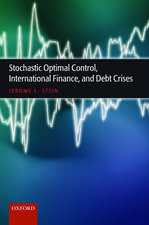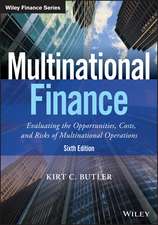Neoliberalism 2.0: Regulating and Financing Globalizing Markets: A Pigovian Approach for 21st Century Markets
Autor L. Nijsen Limba Engleză Hardback – 30 sep 2015
Preț: 652.31 lei
Preț vechi: 767.42 lei
-15% Nou
Puncte Express: 978
Preț estimativ în valută:
124.83€ • 135.55$ • 104.86£
124.83€ • 135.55$ • 104.86£
Carte tipărită la comandă
Livrare economică 22 aprilie-06 mai
Preluare comenzi: 021 569.72.76
Specificații
ISBN-13: 9781137535542
ISBN-10: 1137535547
Pagini: 513
Ilustrații: X, 513 p.
Dimensiuni: 140 x 216 x 29 mm
Greutate: 0.75 kg
Ediția:1st ed. 2016
Editura: Palgrave Macmillan UK
Colecția Palgrave Macmillan
Locul publicării:London, United Kingdom
ISBN-10: 1137535547
Pagini: 513
Ilustrații: X, 513 p.
Dimensiuni: 140 x 216 x 29 mm
Greutate: 0.75 kg
Ediția:1st ed. 2016
Editura: Palgrave Macmillan UK
Colecția Palgrave Macmillan
Locul publicării:London, United Kingdom
Cuprins
Table of Contents List of Tables 1. Introduction 1.1. An Initial Survey 1.2. The Taxation Perspective 1.3. The Neoliberal Context and the Rule of Law . 1.4. Rising Inequality Despite Progressive Tax Systems 1.5. Sequencing the Topics and Justification of the Research Statement 2. Liberalism versus Neo-Neoliberalism 2.1. Introduction 2.2. Dissecting Liberalism 2.2.1. Constituting Principles and (Soft) Demarcation Lines 2.2.2. Classifications 2.2.3. Classical Liberalism 2.2.4. Social Liberalism 2.2.5. Libertarianism 2.3. Positioning Neo-Liberalism and Objective of the Free Market 2.3.1. Historical Dimensions 2.3.2. Classical Neo-Liberalism 2.3.3. Stages in the Emergence of Neoliberalism 2.3.4. The Neoliberal Conception of Freedom 2.3.5. Evaluation 2.4. The Problematic Relation Between the State and the Free Market 2.5. How Neo-Liberalism Differs From Liberalism: A Re-Visitation of the Past 2.6. Neo-Liberalism and the Rule of Law 2.7. Interim Conclusion 3. Changing Sovereignty, Democracy, Individual Freedom and the Evolving Dynamics of Taxation in a Modern Neoliberal State Within Europe 3.1. Introduction 3.2. Development of the Nation State 3.2.1. (Historical) Connotation Between State-Sovereignty and Legitimacy 3.2.2. The Historical Dimensions and Role of Taxation 3.2.3. Sovereignty Dynamics 3.2.4. Application of Those Principles in a 21st Century Characterized by Globalization 3.3. The Role of Individual Freedom: a Back-Test Against Neo-Liberalism 3.3.1. The Different Dimensions of Freedom 3.3.1.1. Negative Freedom 3.3.1.2. Positive Freedom 3.3.2. The Libertarian Concept of Freedom 3.3.3. The Concept of Freedom and the Dynamics of a Modern Welfare State 3.3.4. Freedom and the Neo-Liberal State 3.3.5. Fear, Democracy and the Neoliberal Individual 3.3.6. The Neoliberal State Infrastructure and Neo-Liberal Freedom 3.3.7. Controlled Freedom as Ideology . 3.3.8. Characterization of Neoliberal Freedom 3.3.9. The Neo-Liberal Individual and its Relation to the Democratic Sovereign 3.4. Future Dynamics of Democracy in a (Post)-Neo-Liberal State 3.4.1. The Problem Lies Within the Constituting Elements of Democracy 3.4.2. Democracy and Partial Regional Sovereignty 3.4.2.1. Democracy Implications of EU Membership 3.4.2.2. Democracy Implications of EMU 2.0 Membership 3.4.3. The Issue of Legitimacy in Europe 3.4.4. Democratic Legitimacy in a Non-Optimal Currency Area (EMU 2.0) 3.5. Interim Conclusion 4. Constructing an Alternative Tax Model Against the Background of a Changing (Tax) Sovereignty Paradigm Within the EU 4.1. Introduction 4.2. Evolving Tax Sovereignty 4.2.1. Historical Dimensions 4.2.2. The EU Dimension 4.2.3. The EU's Involvement in Direct Tax Matters 4.2.4. Colliding Principles: Fiscal Sovereignty of Member States and the Direct Effect of EU Law 4.3. Internationalization and Digitalization Affecting Tax Matters 4.4. The Nature of the Willingness to Pay Taxes 4.5. Increasing Instrumentalism and Legitimacy in Tax Matters 4.6. Final Observations Regarding Contemporary Income-Tax Based Systems 4.7. The Pigovian Tax Model 4.7.1. Introduction 4.7.2. Pigou's Original Position and Its Evolution 4.7.3. Critiques on the Pigovian Model 4.7.3.1. Measurement 4.7.3.2. What Externalities to Capture? 4.7.3.3. Reciprocity and Individual Property Rights 4.7.3.4. A Continuous Point of Contention: Non-linear Harm 4.7.3.5. Specific Versus General Balance Analysis 4.7.4. Effects in the Short-Term Versus Long-Term of Pigovian Taxes and the Double-Dividend Hypothesis 4.7.4.1. Longevity of Pigovian Taxes 4.7.4.2. The Double-Dividend Hypothesis 4.7.5. Do Pigovian Taxes Cause Deadweight Loss or Do They Hamper Economic Growth? 4.7.6. Pigovian Taxes and the Ability-To-Pay Principle 4.7.7. Pigovian Tax Credits 4.8. The Concept and Pricing of an Externality 4.8.1. Introduction 4.8.2. The Problem of Variation in Marginal Social Cost 4.8.3. Is it Possible to Refine the Distribution of Marginal Social Costs? 4.8.4. The Pricing of Externalities 4.9. Alternatives to and Derivatives of the Pigovian Model 4.10. Catalogization of Externalities 4.11. The Neoliberal Approach to Externalities 4.11.1. Introduction 4.11.2. Historical Evolution of Neoliberal Thinking 4.11.3. A New Paradigm 4.12. The Neoliberal Individual and Pigovian Taxes 4.13. Interim Conclusion 5. Applying Pigovian Taxes on a Regional Basis: The Quest for a Normative Model 5.1. Introduction 5.2. The Dynamics of Regional Economies and Economic Development 5.2.1. The Anchors of Regional Economic Development 5.2.2. Deeper Economic Integration in the EU 5.2.3. Factors Determining the Level of Economic Integration in an Economic Zone 5.2.4. Measuring Economic Integration 5.3. The Heckscher-Ohlin Model 5.3.1. Introduction 5.3.2. Fundamentals and Mechanics of the Model 5.3.2.1. The H-O Model and Ricardo's Comparative Advantage 5.3.2.2. Assumptions of the H-O Model 5.3.2.3. Mechanisms of the H-O Model 5.4. Evaluation 5.4.1. General Evaluation of the H-O Model 5.4.2. Evaluation of the H-O Model in the Context of Pigovian Taxes 5.4.2.1. Initial Findings 5.4.2.2. The Paradigm of Pigovian Taxes in a Regional Context 5.4.3. Expanding the Catalogue of Externalities 5.4.4. Policy Implications and Opportunities 5.5. Interim Conclusion 6. A Pigovian Approach in a Globalizing Financial Industry 6.1. Introduction 6.2. The Financial Sector and its Regulatory Straitjacket 6.3. Neoliberalism and the Banking Sector 6.4. The Financial Sector and Taxation 6.4.1. The Dutch Bank Tax 6.4.2. The Financial Transaction Tax 6.5. Externalities in the Financial Sector and the Options to Address 6.5.1. Externalities in the Financial Sector 6.5.1.1. The DNA of a Bank and Its Externality-Causing Activities 6.5.1.2. Options to Address Externalities in the Financial Sector 6.5.2. Evaluation of Bank Taxation Models and Expected Outcome 6.5.3. Inadequacy of the Current Bank Levies 6.5.3.1. Financial Transaction Tax 6.5.3.2. Bonus Tax and General Bank Levies 6.6. A Pigovian Tax Model for the FI Industry6.6.1. Introduction 6.6.2. Taxing Systemic Risk in the FI Industry 6.6.2.1. Conceptualization of Systemic Risk 6.6.2.2. The Definition of a Systemically Important FI (SIFI) 6.6.2.3. Taxing Systemically Important FIs 6.6.3. Taxing Firm-Specific Risk in the FI Industry 6.6.3.1. Credit (Risk) Transformation 6.6.3.2. Maturity (or Duration) Risk Transformation 6.6.3.3. Risk Transformation 6.6.3.4. Liquidity Exposure in the FI Sector 6.6.3.5. Leverage-Induced Externalities 6.6.3.6. Volatility-Inducing Externalities 6.7. Pigovian Taxes and the Shadow Banking Industry 6.7.1. Introduction 6.7.2. Securitization 6.7.3. The Repo Market and Securities Lending 6.7.4. Re-Hypothecation and Collateral Lending 6.7.5. Shadow Banking as Market-Based Financing 6.8. Pigovian Taxes as a Macro-Prudential Tool 6.8.1. Introduction 6.8.2. Managing Credit Booms and Busts 6.8.3. Managing (Cross-Border) Capital Flows 6.9. Financialization as the Neoliberal Tool to Penetrate Non-Economic Spheres of Life 6.10. Interim Conclusion 7. Conclusions 7.1. Initial considerations 7.2. The (Pigovian) Tax Dimension in a Neoliberal State Infrastructure 7.3. The Research Questions 7.4. The Financial Industry and Pigovian Taxes in a Globalizing World 7.5. The European Dimension in this Study 7.6. Re-defining the Role of Taxation Going Forward 7.7. Scope For Further Research 7.8. Signing off Index
Notă biografică
Luc Nijs is the founder, chairman and group CEO of The Talitha Group, a global merchant banking group and global investment holding. Before founding The Talitha Group he held positions at Arthur Andersen and Deloitte. Luc also provides advisory, executive coaching and financial training for corporations, investment funds and financial institutions and is active in over 160 countries worldwide on a wide array of strategy, investments and capital allocation issues.
Luc has held academic positions in international taxation, finance and capital markets at UAMS/IPO (Belgium), Instituto de Empresa (Spain) and most recently the Aizkraukles Banka Chair in investment banking, private equity and entrepreneurial finance at the Riga Graduate School of Law (Latvia). Luc's previous titles include the best-selling book Shaping Tomorrow's Marketplace: Investment Philosophies for Emerging Markets and a Semi-Globalized World, Mezzanine Finance: Tools, Applications and Total Return, and The Handbook of Global Agricultural Markets. Luc is fluent in Dutch, French, German, English, Spanish and Portuguese and is competent in Mandarin and Russian.
Luc has held academic positions in international taxation, finance and capital markets at UAMS/IPO (Belgium), Instituto de Empresa (Spain) and most recently the Aizkraukles Banka Chair in investment banking, private equity and entrepreneurial finance at the Riga Graduate School of Law (Latvia). Luc's previous titles include the best-selling book Shaping Tomorrow's Marketplace: Investment Philosophies for Emerging Markets and a Semi-Globalized World, Mezzanine Finance: Tools, Applications and Total Return, and The Handbook of Global Agricultural Markets. Luc is fluent in Dutch, French, German, English, Spanish and Portuguese and is competent in Mandarin and Russian.














